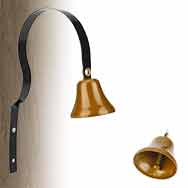Customer waiting alerts in small shops

How shopkeepers of small old shops working with stock at the back of the shop were alerted to customers waiting: the doorbell, counter bell and shouting.
____
Extracted from the memoirs of the webmaster's mother (1906-2002) and edited by the webmaster
Why shop staff needed to be alerted to customers waiting
While I was a young child in 1940s Britain, there were far more small shops than there are today. Many were owned or run as family businesses.
The individuals serving in the shops tended to have to manage the stock as well as serve. So they were kept busy, often out at the back of the shop. In order to know that they had a customer, they needed to be alerted in some way.
There were two types of alert: one attached to the shop door and the other to the shop counter. Both were manual before around the 1950s. There was of course also the customer's voice.
Doorbell alerts
Doorbell alerts were ordinary bells with a clanger which rang as the clanger and bell casing knocked together. It is shown in the top image and again below.

Doorbell over the door of small shops which would sound as the door opened, announcing the arrival of a customer.
These bells were hung from flexible strips of metal or springs placed to that the bell casing would be pushed sideways when the door opened. The more flexible the metal strip or spring, the longer the bell would ring for.
These early bells were manual ones, not electric ones and their characteristic ring couldn't always have been easy for the shopkeeper to hear from out at the back. Later bells were electric, rang for longer and were louder.
Counter bell alerts

Bell on the counter of small shops which a customer could press to bring someone out to serve. Photographed in The Black Country Museum.
Once inside the shop a customer could call the attention of the shopkeeper by ringing a bell screwed on to the shop counter. This bell, too, was manual. The knob at the top had to be pressed smartly down to drive the clanger against the bell casing. It was not an electric press button switch. It had the advantage over the doorbell in that customers could press it more than once if the shopkeeper did not seem to have heard the first time.
Customers shouting for service
Customers readily accepted that there might not be an assistant behind a counter to serve them because it was so common. Whereas today we might try a tentative 'Hello', the standard was to shout out 'Shop'. When I was with my mother when she did it in the 1970s, I felt very embarrassed.
Shops empty of sales assistants must have been ideal for shoplifting but it apparently wasn't sufficient of a problem for anyone to mention it in my hearing or for my mother to write about in her memoirs.
| sources | webmaster | contact |
Text and images are copyright
If you can add anything to this page or provide a photo, please contact me.



